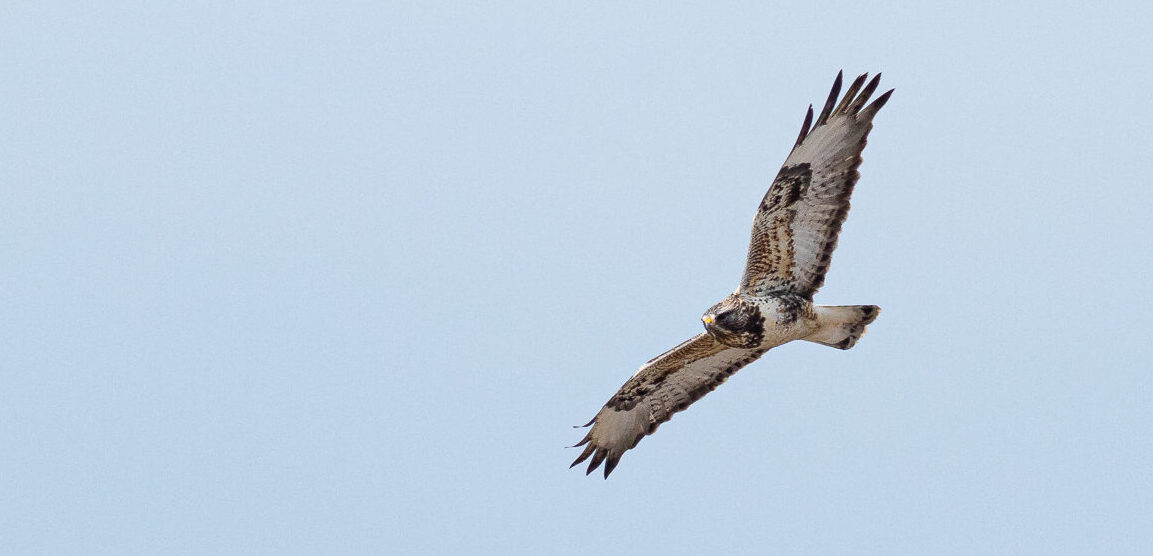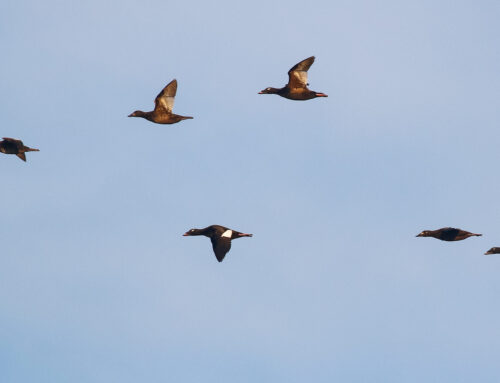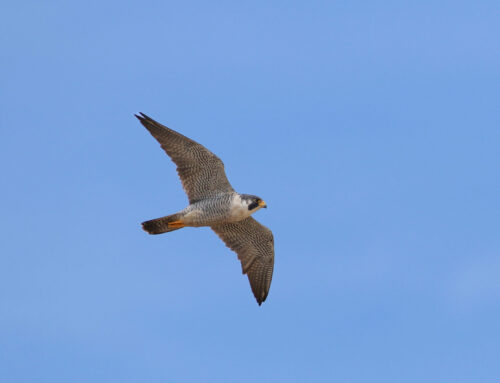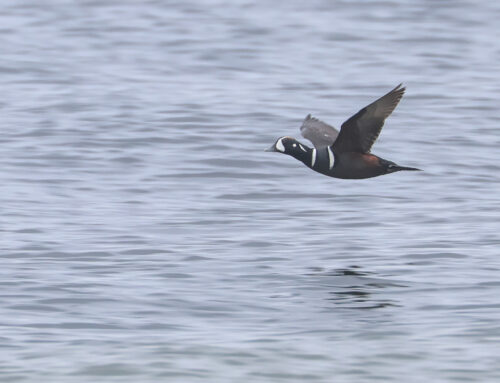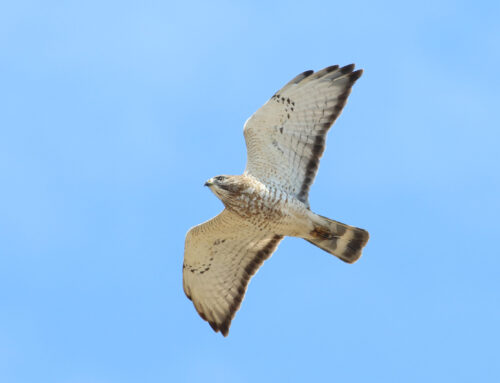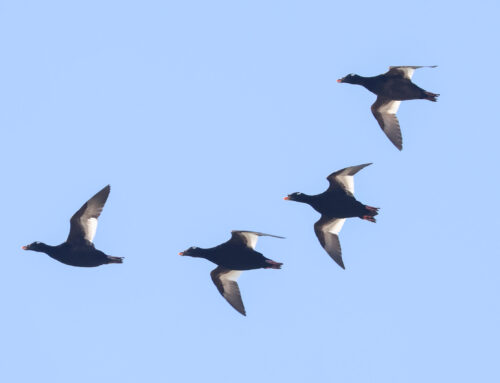The WPBO spring raptor count has continued to gain momentum over the past week. As we cross into the second half of April, nearly 2,800 migrant raptors have pushed north past the Point since this year’s count began. April 11 brought less favorable migration conditions as blustery northwest winds blew in off the lake for most of the count, resulting in the first lower double-digit day count of the season so far. The non-raptor highlights on that dreary cold day were (1) a female SHARP-TAILED GROUSE making two passes south of the hawk platform before perching atop one of the nearby pines to the north, spending several minutes hanging out before dropping back down into cover again and (2) a BLUE-GRAY GNATCATCHER calling and fluttering around the treeline to the south of the platform in the morning hours, later appearing at the feeders. More favorable southerly winds returned the following day, and a strong SHARP-SHINNED HAWK flight poured over the dunes in the first morning hours of the count (well over 100 in the first three hours). While mixed in with the tiny accipiters, a lone juvenile NORTHERN GOSHAWK made a low pass at treetop level to the north of the platform — close enough to make out the white slash of an eyebrow marking without even lifting binoculars to one’s eyes. As the sharpies slowed, a nice push of RED-TAILED HAWKS gained their own momentum in the early afternoon hours. April 13 brought the spring count’s first BROAD-WINGED HAWK — a very early migrant heading north, with the most recent earliest record from the spring count before this year dating back to April 12, 2015. After being spotted distant to the south, the adult bird slowly chugged north with emphatic wing flaps until it reached just before the platform, making an abrupt 180-degree turn (perhaps upon seeing the water and long cross into Canada), and returned towards the southern horizon out of view.
April 14 saw another robust triple-digit SHARP-SHINNED HAWK push throughout the day; however, the following two days (April 15 and 16) would bring the first noticeably large push of migrant raptors, with just over a thousand passing north over that time.
While brewing coffee and making breakfast, I received an early morning text just minutes before sunrise on April 15 from the owl banders, Chris and Nova: “Hawks moving early today. Looks like it might be a fun day if they don’t go high.” As I pulled into the parking lot in front of the lighthouse, a pair of sharpies spiraled low overhead above the trees as a frosty southwest wind swept through their leaves: Migration was on! There was barely enough time to set up a scope and take the first quick sips of hot coffee before ROUGH-LEGGED HAWKS began zipping northeast over the dune treeline. In just the first hour, I observed 17, followed by a burst of 41 in the next, and the momentum did not relent until early afternoon. A total of 124 roughies would pass by before the end of the count, with birds continuing to migrate north well into the late day.
While the excitement was easy to focus on the mosaic of light and dark morph migrant roughies, SHARP-SHINNED HAWKS poured out of the sky while mixed in with their buteo companions — a total of 521 would pass the platform before the day’s end. A seemingly continuous flurry of small flapping accipiters buzzed north in all directions. While the raptor flight provided ample counting entertainment, the non-raptor highlight from the hawk platform was 3,064 SANDHILL CRANES pushing north in large groups throughout the day. The guttural calls of the large birds rang out into the skies for hours as they approached from the south, spiraled in erratic, cacophonous circles before deciding whether or not to make the heroic 20-mile open water cross over the lake into Canada. This was a great first big day of the spring count; however, the following day also brought an exciting second consecutive triple-digit ROUGH-LEGGED HAWK flight (102), likely the residual birds to the south that did not pass the previous day. A large storm system moved in from the south and landed on the Point by mid-afternoon, and one could witness from below a mix of buteos riding the leading edge of the storm wall to get a jump on the poor weather. As the ominous dark clouds approached, large kettles of RED-TAILED HAWKS and ROUGH-LEGGED HAWKS continued to spiral and push north ahead of the impending rain. Shortly after the last birds glided northeast over the lake, raindrops plummeted onto the hawk platform, and the count ended. The non-raptor highlights on the day were a pair of BOREAL CHICKADEES flitting through the nearby pine trees off the platform, among the massive BLACK-CAPPED CHICKADEE flocks that have continued to build and circle the Point for days.
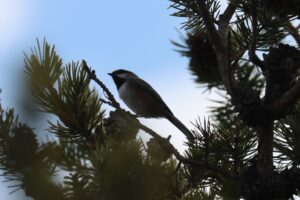
Several Boreal Chickadees hung around the hawk platform on April 15 and 16 as large Black-capped Chickadee flocks (as many as 100) flew around the Point.
Today (April 17) saw a return to less favorable migration conditions as a dreary gray sky coupled with south winds that quickly shifted to northwest off the lake did not promote much raptor movement. A highlight of the day was a juvenile/subadult GOLDEN EAGLE spiraling several miles south of the platform but never making it farther north to pass. Snow is in the immediate forecast and may shut down much of a flight tomorrow and into the early part of this week; however, the days ahead still look promising. We are already on track for having an above-average spring count for ROUGH-LEGGED HAWK. Historically, May can also bring good movement of roughies (while we await the next large migrant pushes of other northbound raptors). Grab your binoculars or scope and make the trek up the Point to catch some of the spring raptor migration this year before the birds head north!
~ Jess Cosentino
2023 Spring Raptor Counter
Featured photo: Rough-legged Hawk. Photo by Rich Couse

